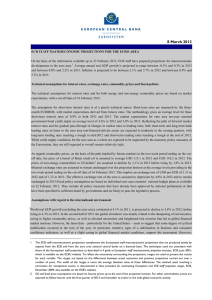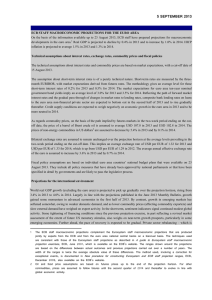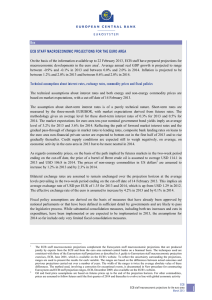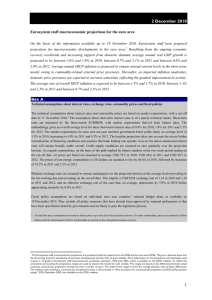2 SEPTEMBER 2010
advertisement
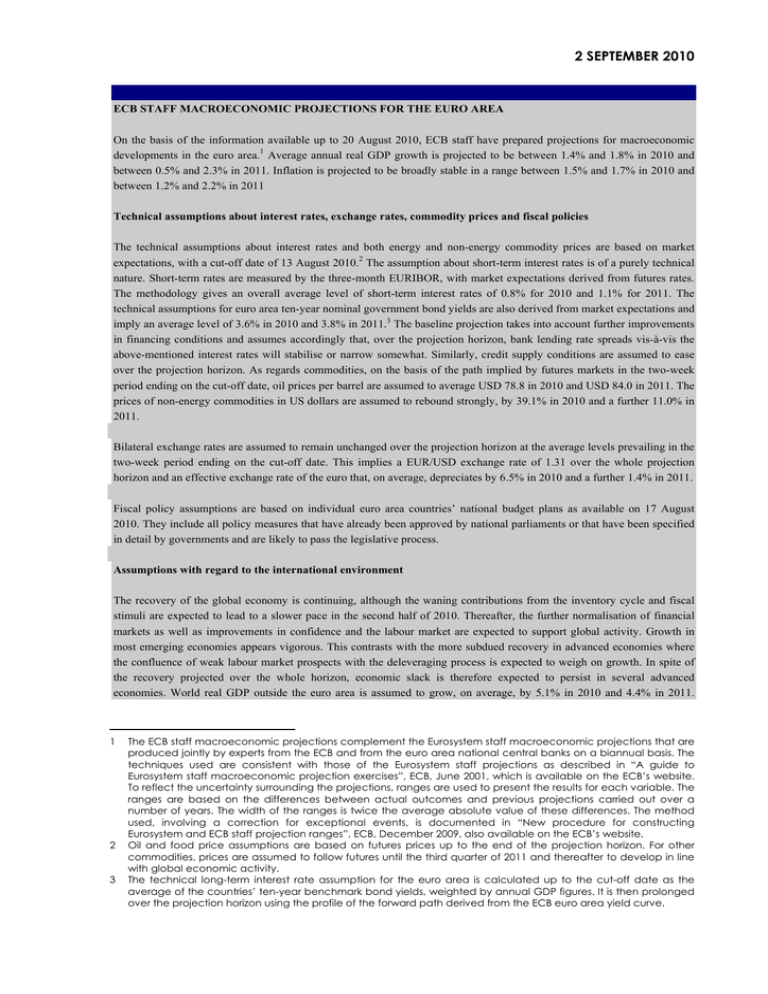
2 SEPTEMBER 2010 ECB STAFF MACROECONOMIC PROJECTIONS FOR THE EURO AREA On the basis of the information available up to 20 August 2010, ECB staff have prepared projections for macroeconomic developments in the euro area.1 Average annual real GDP growth is projected to be between 1.4% and 1.8% in 2010 and between 0.5% and 2.3% in 2011. Inflation is projected to be broadly stable in a range between 1.5% and 1.7% in 2010 and between 1.2% and 2.2% in 2011 Technical assumptions about interest rates, exchange rates, commodity prices and fiscal policies The technical assumptions about interest rates and both energy and non-energy commodity prices are based on market expectations, with a cut-off date of 13 August 2010.2 The assumption about short-term interest rates is of a purely technical nature. Short-term rates are measured by the three-month EURIBOR, with market expectations derived from futures rates. The methodology gives an overall average level of short-term interest rates of 0.8% for 2010 and 1.1% for 2011. The technical assumptions for euro area ten-year nominal government bond yields are also derived from market expectations and imply an average level of 3.6% in 2010 and 3.8% in 2011.3 The baseline projection takes into account further improvements in financing conditions and assumes accordingly that, over the projection horizon, bank lending rate spreads vis-à-vis the above-mentioned interest rates will stabilise or narrow somewhat. Similarly, credit supply conditions are assumed to ease over the projection horizon. As regards commodities, on the basis of the path implied by futures markets in the two-week period ending on the cut-off date, oil prices per barrel are assumed to average USD 78.8 in 2010 and USD 84.0 in 2011. The prices of non-energy commodities in US dollars are assumed to rebound strongly, by 39.1% in 2010 and a further 11.0% in 2011. Bilateral exchange rates are assumed to remain unchanged over the projection horizon at the average levels prevailing in the two-week period ending on the cut-off date. This implies a EUR/USD exchange rate of 1.31 over the whole projection horizon and an effective exchange rate of the euro that, on average, depreciates by 6.5% in 2010 and a further 1.4% in 2011. Fiscal policy assumptions are based on individual euro area countries’ national budget plans as available on 17 August 2010. They include all policy measures that have already been approved by national parliaments or that have been specified in detail by governments and are likely to pass the legislative process. Assumptions with regard to the international environment The recovery of the global economy is continuing, although the waning contributions from the inventory cycle and fiscal stimuli are expected to lead to a slower pace in the second half of 2010. Thereafter, the further normalisation of financial markets as well as improvements in confidence and the labour market are expected to support global activity. Growth in most emerging economies appears vigorous. This contrasts with the more subdued recovery in advanced economies where the confluence of weak labour market prospects with the deleveraging process is expected to weigh on growth. In spite of the recovery projected over the whole horizon, economic slack is therefore expected to persist in several advanced economies. World real GDP outside the euro area is assumed to grow, on average, by 5.1% in 2010 and 4.4% in 2011. 1 2 3 The ECB staff macroeconomic projections complement the Eurosystem staff macroeconomic projections that are produced jointly by experts from the ECB and from the euro area national central banks on a biannual basis. The techniques used are consistent with those of the Eurosystem staff projections as described in “A guide to Eurosystem staff macroeconomic projection exercises”, ECB, June 2001, which is available on the ECB’s website. To reflect the uncertainty surrounding the projections, ranges are used to present the results for each variable. The ranges are based on the differences between actual outcomes and previous projections carried out over a number of years. The width of the ranges is twice the average absolute value of these differences. The method used, involving a correction for exceptional events, is documented in “New procedure for constructing Eurosystem and ECB staff projection ranges”, ECB, December 2009, also available on the ECB’s website. Oil and food price assumptions are based on futures prices up to the end of the projection horizon. For other commodities, prices are assumed to follow futures until the third quarter of 2011 and thereafter to develop in line with global economic activity. The technical long-term interest rate assumption for the euro area is calculated up to the cut-off date as the average of the countries’ ten-year benchmark bond yields, weighted by annual GDP figures. It is then prolonged over the projection horizon using the profile of the forward path derived from the ECB euro area yield curve. Reflecting the significant recovery in global trade, growth in the euro area’s export markets is assumed to increase by 10.4% in 2010 and 7.1% in 2011. Real GDP growth projections Euro area real GDP growth rebounded strongly in the second quarter of 2010. Available information suggests that domestic demand grew strongly, partly because investment surged after adverse weather conditions affected the first quarter, while net exports and inventories also contributed to growth. Over the remainder of 2010, as previously envisaged, the rate of growth is expected to diminish somewhat, as the factors that temporarily boosted growth in the initial phase of the recovery – such as fiscal stimuli, the inventory cycle and the rebound in trade – lose some strength. Looking further ahead, economic activity is projected to pick up, supported by the recovery in exports and by gradually rising domestic demand, reflecting the effects of past monetary policy moves and significant efforts to restore the functioning of the financial system. However, compared with previous cycles, the recovery is projected to remain rather moderate, owing to the need for balance sheet repair in various sectors. Private consumption is also expected to be affected by modest income dynamics. In addition, the outlook also takes into account ongoing fiscal adjustments aimed at consolidating confidence in medium-term sustainability. In annual terms, following a decline of 4.0% in 2009, real GDP growth is expected to rebound but remain moderate over the horizon, ranging between 1.4% and 1.8% in 2010 and between 0.5% and 2.3% in 2011. As estimates of annual potential growth are also projected to be lower than pre-crisis rates, the output gap is expected to narrow over the projection horizon. Table A Macroeconomic projections for the euro area 1), 2) (average annual percentage changes) HICP 2009 0.3 2010 1.5 – 1.7 2011 1.2 – 2.2 Real GDP -4.0 1.4 – 1.8 0.5 – 2.3 Private consumption Government consumption Gross fixed capital Exports (goods and Imports (goods and -1.1 2.6 0.0 – 0.4 0.3 – 1.3 -0.1 – 1.5 -0.1 – 1.1 -11.0 -13.2 -11.8 -2.3 – -0.7 7.4 – 10.0 5.8 – 8.2 -1.6 – 3.0 2.9 – 9.3 1.6 – 7.8 1) The projections for real GDP and its components are based on working day-adjusted data. The projections for imports and exports include intra-euro area trade. 2) Estonia is included in the euro area projections for 2011. The average annual percentage changes for 2011 are based on a euro area composition in 2010 that already includes Estonia. Price and cost projections Having reached 1.6% in August, overall HICP inflation is projected to increase slightly by the end of the year, largely owing to effects from commodity price developments. Later on, while imported inflation moderates, domestic price pressures are expected to increase alongside the gradual improvement in activity, leading to a slow rise in the inflation of the HICP excluding food and energy. Overall, inflationary pressures are, however, expected to remain contained until 2011, with headline inflation being projected to be broadly stable overall at annual rates between 1.5% and 1.7% in 2010 and 1.2% and 2.2% in 2011. Growth in compensation per hour in the euro area is projected to decrease in 2010. As the labour market situation remains weak, little additional wage pressure is expected in 2011. Taking into account the expected strong recovery in labour productivity, the projected profile of wages implies a substantial decline in unit labour costs in 2010. This, in turn, is projected to allow a strong recovery in profit margins from the substantial contraction experienced in 2009, with more modest growth thereafter. 2 Comparison with the June 2010 projections Compared with the Eurosystem staff macroeconomic projections published in the June 2010 issue of the Monthly Bulletin, the projection range for real GDP growth in 2010 lies significantly above the previous range, reflecting mainly the stronger than anticipated rebound in growth in the second quarter as well as indications of better than expected developments later in the year. For 2011 the range has been revised slightly upwards, reflecting mainly carry-over effects from the projected stronger growth towards the end of 2010. With regard to HICP inflation, the range for 2010 has been adjusted marginally upwards with respect to that of June 2010, while for 2011 the lower end of the range has been revised slightly upwards. Table B Comparison with the June 2010 projections (average annual percentage changes) Real GDP – June 2010 Real GDP – September 2010 HICP – June 2010 HICP – September 2010 2009 -4.1 -4.0 2010 0.7 – 1.3 1.4 – 1.8 2011 0.2 – 2.2 0.5 – 2.3 0.3 0.3 1.4 – 1.6 1.5 – 1.7 1.0 – 2.2 1.2 – 2.2 Comparison with forecasts by other institutions A number of forecasts for the euro area are available from both international organisations and private sector institutions. However, these forecasts are not strictly comparable with one another or with the ECB staff macroeconomic projections, as they were finalised at different points in time. Additionally, they use different (partly unspecified) methods to derive assumptions for fiscal, financial and external variables, including oil and other commodity prices. Finally, there are differences in working day adjustment methods across different forecasts (see the table below). According to the forecasts currently available from other organisations and institutions, euro area real GDP is expected to range between 0.9% and 1.2% in 2010. This is below the range of the ECB staff projections and likely reflects the fact that the forecasts were made before the release of data showing strong growth in the second quarter of the year. The range of projections for 2011 is between 1.3% and 1.8%, which is well within the range of the ECB staff projections. As regards inflation, available forecasts anticipate average annual HICP inflation to be between 1.1% and 1.5% in 2010, which is slightly below the range of the ECB staff projections. HICP inflation forecasts for 2011 range between 1.0% and 1.7%, all but the OECD forecast being within the range of the ECB staff projections. Table C Comparison of forecasts for euro area real GDP growth and HICP inflation (average annual percentage changes) Date of release GDP growth HICP inflation 2010 2011 2010 2011 OECD May 2010 1.2 1.8 1.4 1.0 European Commission May 2010 0.9 1.5 1.5 1.7 IMF July 2010 1.0 1.3 1.1 1.3 Survey of Professional Forecasters July 2010 1.1 1.4 1.4 1.5 August 2010 1.2 1.4 1.5 1.6 September 2010 1.4 – 1.8 0.5 – 2.3 1.5 – 1.7 1.2 – 2.2 Consensus Economics Forecasts ECB staff projections Sources: European Commission spring forecast, May 2010; IMF World Economic Outlook, April 2010, for inflation, and World Economic Outlook Update, July 2010, for GDP growth; OECD Economic Outlook, May 2010; Consensus Economics Forecasts; and the ECB’s Survey of Professional Forecasters. 3 Note: The ECB staff macroeconomic projections and the OECD forecasts both report working day-adjusted annual growth rates, whereas the European Commission and the IMF report annual growth rates that are not adjusted for the number of working days per annum. Other forecasts do not specify whether they report working day-adjusted or non-working day-adjusted data. 4

